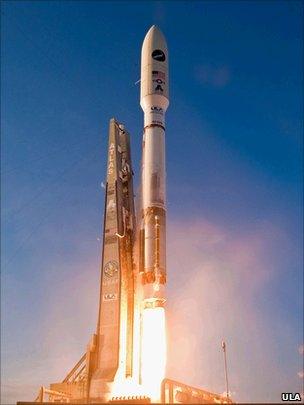Atlas rocket in line for human launches
- Published

The Atlas 5 has a 100% record
Nasa has taken another important step in its efforts to replace the shuttle with a commercial system to take astronauts into space.
The agency has signed an agreement with United Launch Alliance (ULA) to assess its Atlas 5 rocket for use in human missions.
The Atlas is currently used to loft US military satellites as well as unmanned science probes for Nasa.
It has an excellent record, having completed 26 flights with no failures.
When Nasa lands its Atlantis shuttle on Thursday, it will have no means of getting American astronauts into orbit. In the short-term it will rely on Russian Soyuz rockets and capsules, but eventually it hopes to buy transportation services from US commercial operators.
"With the shuttle landing here in a few days it does not mean the end of human spaceflight; it means that chapter is going to finish and we're going to pick up with a new chapter," said Ed Mango, Nasa's Commercial Crew Programme manager.
"And today, with our agreement with ULA, I believe we are taking some of those steps to continue on with that tradition of being leaders in human spaceflight."
The Atlas has been chosen as the rocket of choice by three private companies that are in the process of developing ships capable of ferrying crews to the International Space Station (ISS).
Monday's Space Act Agreement (SAA) signed between Nasa and ULA will help determine whether the rocket is up to the task.
The SAA involves no exchange of funds. ULA, which is a joint venture between rocket manufacturers Boeing and Lockheed Martin, will instead invest its own money in the review which is expected to last six to nine months.
The work will determine which components on the Atlas already meet Nasa's stringent requirements for human spaceflight and which elements might need to be upgraded if the rocket is to be certified for astronaut missions.
In parallel with this assessment, ULA will also be continuing development on its Emergency Detection System that would be placed in the Atlas to give warning of a major malfunction.
In such an event, the EDS would trigger the abort mechanism on the crewship atop the rocket, carrying this vehicle and its astronauts to a safe distance.
"From its roots as the launch vehicle for the manned Mercury programme in the 1960s, each new generation of the Atlas system has demonstrated advancements in reliability and performance," said George Sowers, ULA's vice president of business development.
"The Atlas 5 is the proud inheritor of decades of improvements and lessons learned. The Atlas programme has a record of 97 consecutive successes - that's the best in the world. The Atlas 5 has launched 26 times with 100% success," he told reporters.

SNC wants to launch its Dream Chaser crewship atop an Atlas 5
Sierra Nevada Corporation (SNC), Blue Origin, and Boeing itself are receiving funds from Nasa to help them develop spacecraft that could transport up to seven astronauts to the ISS. All three companies would like to launch their vehicles on an Atlas 5. A fourth company in receipt of Nasa funds, SpaceX, would use its own rocket to launch a crewship.
Although the SSA covers work done on the Atlas 5 only, ULA says it is also assessing its Delta 4 rocket for human launches.
Nasa is developing a capsule to go beyond the ISS called Orion. This is much heavier than the private astronaut taxis that want to use the Atlas 5.
ULA says the greater power afforded by a Delta 4 could be used to launch Orion, if Nasa wanted to take that option.